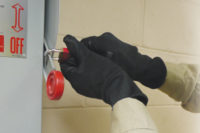You have likely heard of NFPA 70E but may not have heard of NESC. NESC is the National Electric Safety Code (Canadian equivalent CAN/UL S801). This is an ANSI/IEEE standard for utility wiring. It governs most utility properties and can affect non-utility systems, especially transmission and distribution systems commonly found in large industrial plants. OSHA 1910.269 and NESC cover the same basic equipment, and OSHA used NESC in some of the legislation for 1910.269. Most industrial electrical work is covered by the OSHA 1910.300 series and NFPA 70E in the U.S. (Canadian equivalent CSA Z462). The two committees have very few links other than the ASTM arc flash test standards and specifications, so differences are marked. Below are the key areas of change coming in 2012 to affect the workplace.
Face protection
NESC has no clear requirement to protect a worker’s face from arc flash though OSHA stated in 1991 the following:
“OSHA 1910.335(a)(1)(v) Employees shall wear protective equipment for the eyes or face wherever there is danger of injury to the eyes or face from electric arcs or flashes or from flying objects resulting from electrical explosion.”
Face protection will change substantially in 2012 from the standard changes. The NFPA 70E changes include:
1. More openness for arc flash suit hoods. New definition of arc flash suit includes the hood to allow for balaclava/goggle assemblies. The definition is 360-degree protection so the company has freedom to choose the best system for all hazards. The committee stopped short of recommending these systems when using the HRC tables. HRC 3 and HRC 4 require an arc flash suit hood but this is not clearly defined; but the term “bee-keeper’s style hood” has been removed from the requirement.
2. More calculations, less table use. When >12 cal/cm² are anticipated, an arc flash suit hood is recommended in Annex H in the 2012 standard and is required by article 130.7(C)(10)(2). (Before, only HRC categories had requirements of WHEN to wear a hood, but the HRC’s do not apply when companies calculate.) This confusion is perpetuated by consultants, software systems and misunderstanding of NFPA 70E table 130.7(C)(16), which only applies to use of Table 130.7 (C)(15)(a) or (b). This is not to say a company would not benefit from PPE levels equivalent to the HRC categories, but HRC’s are non-mandatory when calculations have been performed. The new Annex H will drive much of the change in the coming year.
3. HRC 2 will include a balaclava under the faceshield. HRC 2* has been eliminated (HRC 2 is now the same as the old HRC 2*). This change will result in more companies moving away from using the tables to calculating. However, proximity of the face to the arc flash should be considered when deciding whether or not to use a balaclava with the faceshield in your PPE levels. However Article 130.7(C)(10) now requires an arc-rated balaclava be worn with an arc-rated faceshield any time the back of the head is within the arc flash boundary. The non-mandatory annex H recommends using the balaclava for exposures >1.2 cal/cm² and <12 cal/cm².
Work practices
1. The energized work permit in NFPA 70E will now be required before passing the “limited approach boundary” or anytime work is being performed within the arc flash boundary, Article 130.2(B)(1).
2. Arc protection blankets (ASTM F2676) and arc protection shields (ASTM F2522) are now listed in the standard making awareness of these work practice devices more visible. These could reduce the risk or need for PPE when used properly.
3. Use of electrical hazard (EH) and dielectric (DI) shoes have been clarified. EH is now recommended and DI is still required for certain work conditions. All electricians should use EH shoes for all electrical work and DI shoes (or overshoes) when step potential is suspected (wet work conditions, grounding near powerlines, walking near potential downed powerlines, some other work situations).
NFPA 70E has little room for alternative options for energized electrical work, while the NESC rules are very open and can even be altered by the “person in charge” in the field to effect adequate safety for workers doing energized work. Historically NESC has been rather open because utilities do work differently in various parts of the U.S. The western states often require use of “hotsticks” to do all energized electrical work >600V, so rubber glove rules do not often apply. However, some of this is changing due to the increased use of underground electrical distribution systems which are often not very friendly to “hotsticks”.
Multilayer clothing systems
Multilayer systems clothing will become more prevalent especially for utility companies. Tables in NESC for arc hazard assessment give a range of energy levels for certain types of equipment within a voltage range. If a company has a system voltage of less than 51kV, these tables characterize exposure energy in 500V padmounts, cabinets, self-contained meters, transformers and cabinets to 20 cal/cm² based on EPRI and utility testing from PG&E. The use of arc rated undershirts added to arc rated shirts will likely surpass the use of low level flash suits as companies realize this is more efficient for the average electrician than donning a low level flash suit or coverall. One company’s study indicated changing into a coverall one time a day for energized electrical work would pay to rent a uniform for a $50/hr. electrician.
More arc flash gloves
More stringent glove requirements, especially the new leather minimum thickness requirement of 0.7 mm, will drive people to consider other options. Leather will remain the choice for protectors for the foreseeable future in the U.S. as the standard specification has no performance requirements. ASTM F696 specifies “leather” tanned with a certain standard and with minimum thickness requirements. There are no specific cut or puncture requirements, just a leather requirement.
ASTM is in the final deliberations on a glove arc test method which will guide companies attempting to protect workers operating electrical equipment doing tasks that have no shock hazard (such as operating disconnects, motor control center operation and low voltage switchgear operation), require arc protection, but do not require shock protection. Many of these workers are commonly performing tasks that require cut or chemical protection that could not be performed — or does not need to be performed — with rubber insulating (voltage rated) gloves and leather protectors. Many knit gloves and coated knit gloves have been developed and are currently reporting arc ratings from this draft standard. Cross-over use gloves are the wave of the future and, in the near future, expect polymers that can outperform rubber in shock and arc protection.



